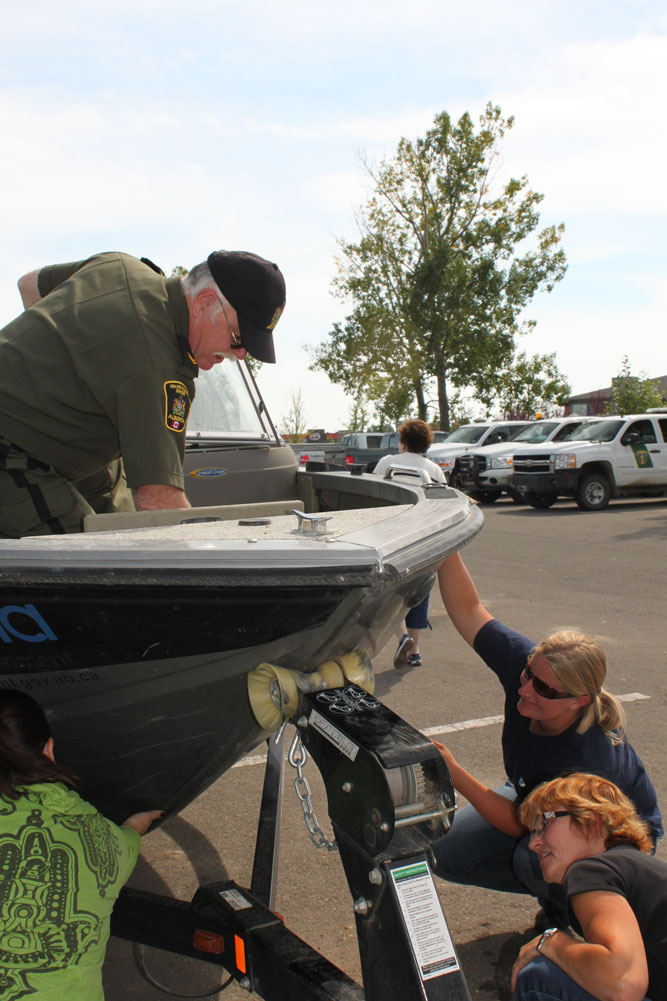An Eurasian species of fresh water mussels, which made its way into Eastern North America possibly via ballast water from boats on the Great Lakes in 1988, is now on the move westward with the 2007 contamination of the Lake Mead Recreational Area by Las Vegas. While contamination was originally noted east of the 100 meridian it has now moved to other western lakes, canals and reservoirs south of the border.
These very aggressive Zebra and Quagga mussels, which attach themselves to soft and hard surfaces, can multiply from one to over one million in just one year causing havoc at economical, environmental and health levels according to Cindy Sawchuk, Aquatic Invasive Species (AIS) Project Manager from Canmore.
Putting our waterways at risk is the transportation of watercraft, float planes and water equipment which may have these “hitchhikers” attached from exposure to infected areas. “The mussels are a threat to Alberta’s 14 billion dollar water operated infrastructure capable of plugging screens, pipes, and irrigation lines,” said Kate Wilson from Alberta Environment and Sustainable Resource Development (ESRD), who led the day’s events. It was apparent from the mussel coated pipe on display that this is a concern needing immediate attention.
Once an infestation has occurred it is impossible to rid the water of the mussels. A small amount of money spent on prevention will save millions if not billions of dollars on maintenance down the road. Besides economical impact the mussels are a threat to existing fish by filtering existing food for themselves and excreting toxic algae which move through the food chain. Diving ducks have been affected in Lake Michigan resulting in the loss in numbers of tens of thousands, while fish species are becoming smaller.
Town Hall was the site for Level 1 training in Alberta AIS and Watercraft Inspection Training last Wednesday put on by ESRD. This training session was attended by Fish and Wildlife Officers, Municipal Employees, Town Parks Department Employees, Municipal Peace Officers, Western Irrigation District (WID) Employees and Conservation Officers. Participants were given background information about these “aliens” and learned how to do a thorough boat inspection.
Councilor Heather Davies, who takes a huge interest in lake quality, joined the training certification. She has been a volunteer with the Alberta Lake Management Society (ALMS) since 1990. This is an educational and data gathering nonprofit society, which samples lake water throughout Alberta in its mandate to promote lake and watershed protection and management throughout the province. Davies said that the town has come on board immediately, “We are asking where boats (launched at Peake Park) have been in the last 30 days, as well as educating boaters about the mussels.” The mussels can live on dry land for 30 days attached to anything from a flip-flop to the inside of a propeller. Its immature larval stage can live in standing water that may be present on a boat or can even attach to boat sides. She said she will be contacting the WID biologist to come up with a collaborative plan of action.
“A Ministerial Order is now in the draft stage waiting to be signed by Deputy Minister Dana Woodworth which will give Alberta Fish and Wildlife Officers the official backup to enforce control measures needed to eradicate any mussels from entering the province,” said Fish and Wildlife Biologist Gavin Berg. A Federal Act coming next spring will regulate the international border.
An overhead map identified hot spots for the mussels throughout the United States which included Utah, Arizona, and Nevada. As the present time Washington, Oregon, Idaho, Montana and Wyoming have remained mussel free. Wilson pointed out that risks are higher for infestation in Alberta, since the recession has made boat purchases from our southern neighbor more attractive. As well it’s a destination for many “Snowbird” Albertans who may haul their boats over the border during the winter season.
Doctor Ron Zurawell, Limnologist and Water Quality Specialist for ESRD said studies have shown that many lakes throughout the province have ideal conditions for breeding of the Quagga mussels, which are cold water adaptable. Zurawell is also part of ALMS and said that monitoring for any presence of the mussels will be added to their list of tests. “It is like finding a needle in a haystack,”he said of these efforts so prevention really is the best bet to stopping an invasion.
As part of the Level 1 Certification a mock infestation was set up on boats with participants having to locate the immature veligers and adult mussels. Decontamination measures include physical removal of the mussels as well as a hot water treatment of 60 degrees Celsius. All water used or removed must not reenter the water supply. Another method is to allow a boat to sit for at least 30 days out of water ensuring the death of the mussels.
Sachiko said that the most effective measure in place now is the hotline number which is used to report any suspicious infestations as well as increasing awareness and providing information. The new legislation coming up for approval, new programs for monitoring and reporting, as well as ongoing inspections are all part of the plan for prevention and spreading. The aquatic hotline number is 1-855-336-BOAT.
From this information session it is apparent that we all have a responsibility in keeping our lakes and waterways mussel free and collaborative efforts between all groups and individuals will be necessary. Mussel infestations are a dramatic change to the water environment we don’t want to see and have the ability to prevent.










1 Comment